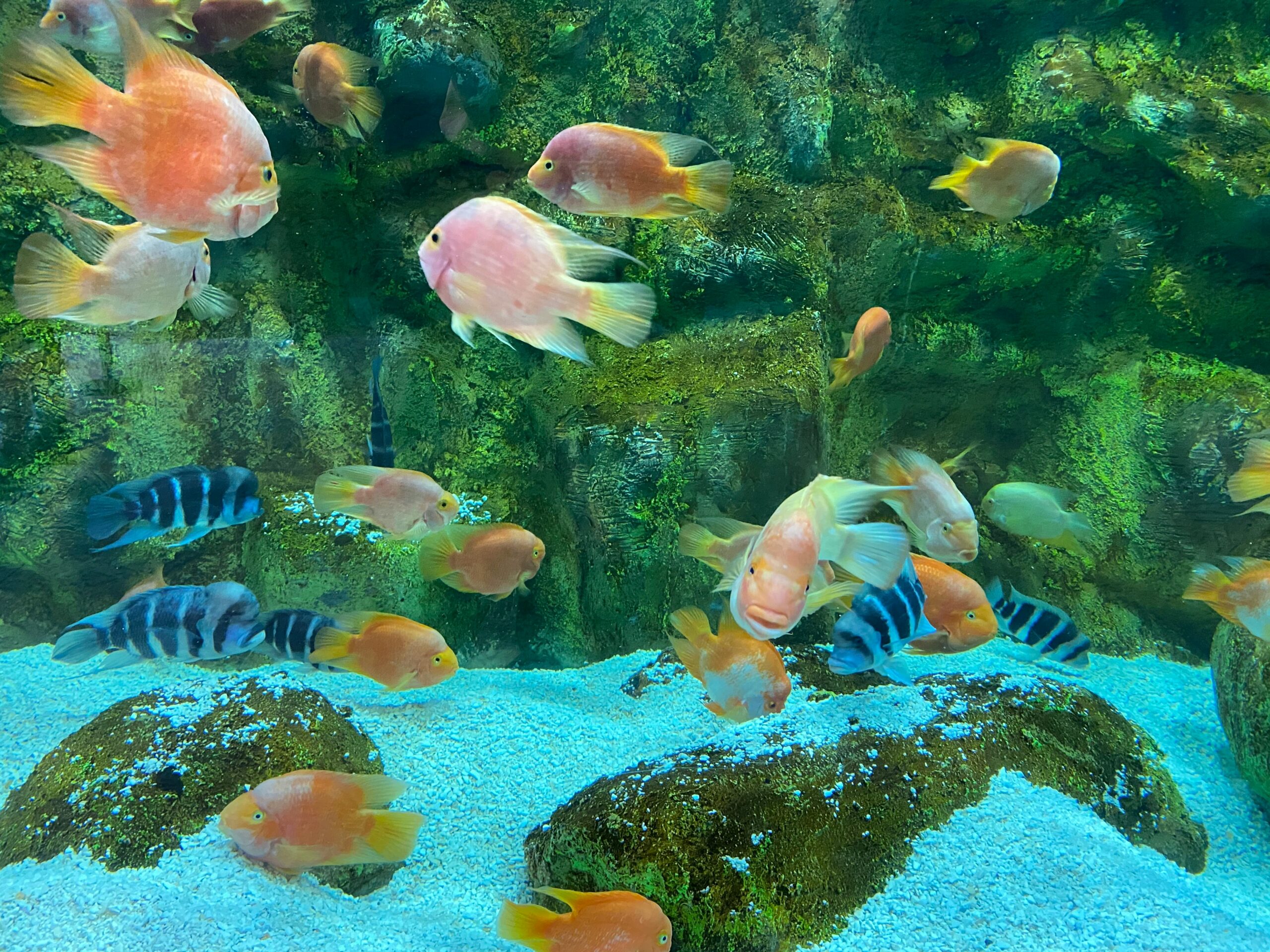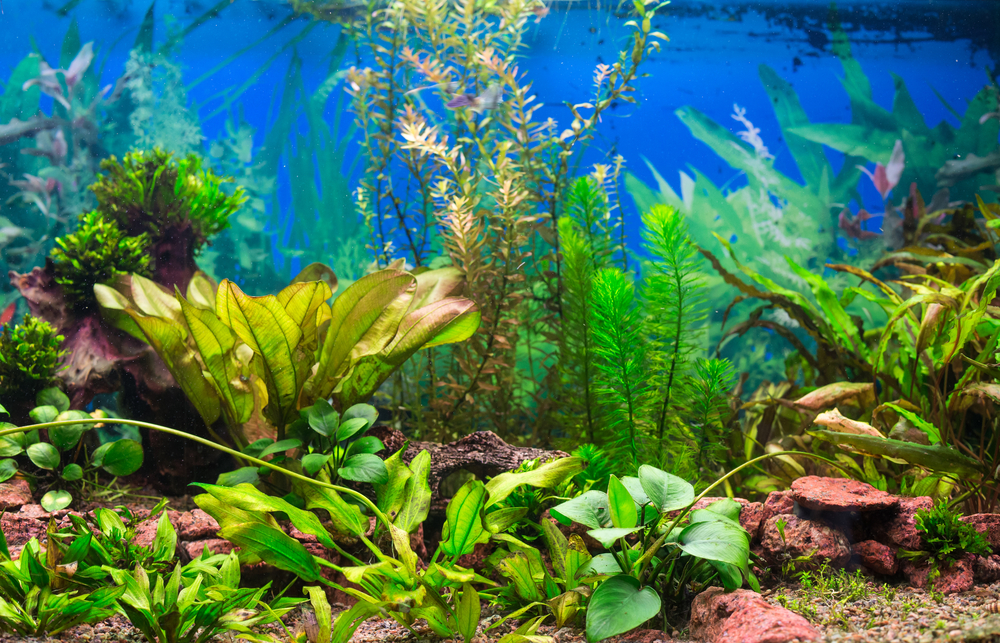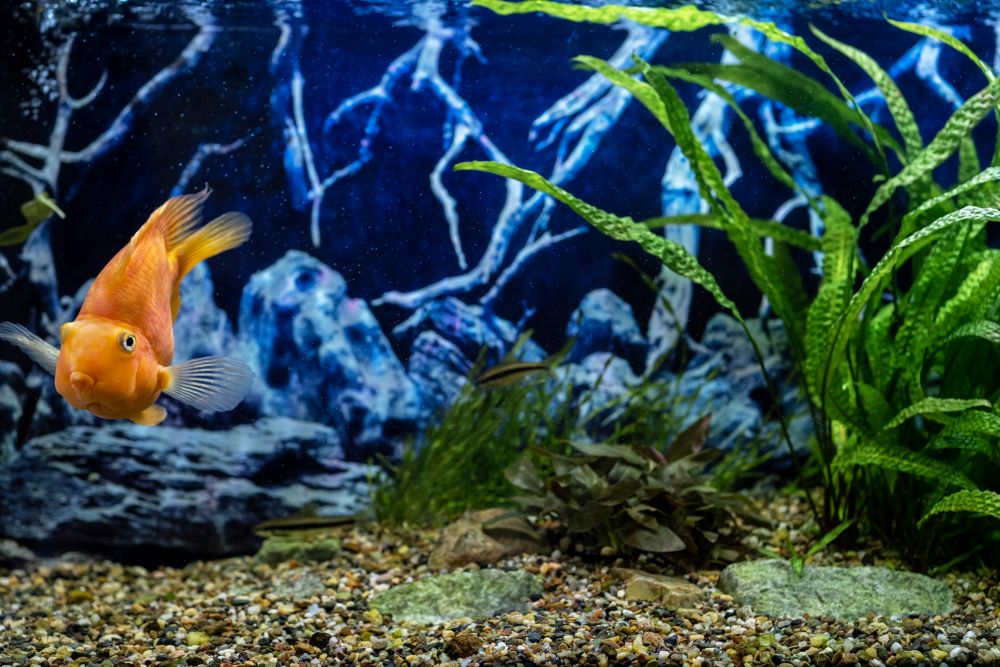7 Easy Hacks for a Crystal-Clear Fish Tank (That Work Fast)
When you purchase through links on our site, we may earn a commission. Here’s how it works.
Table of Contents

1. The Fastest Way to Clear Cloudy Aquarium Water
If your fish tank looks like someone hit “blend” on it, don’t panic. You can get crystal-clear water fast with one simple combo: a good rinse and a quick clarifier boost.
Here’s the move:
- Unplug and rinse your filter sponge or pad in a bowl of tank water (never tap water, as chlorine kills the good bacteria).
- Pop in a few drops of a water clarifier that’s safe for fish. These make the tiny floating particles clump together so your filter can grab them.
- Turn your filter back on and watch the fog lift in 30–60 minutes.
Pro Tip: If you don’t have a clarifier on hand, toss in a small piece of filter floss or a polishing pad, and it’ll catch the same gunk.
Find the Best Water Clarifier for Your Tank. Before you grab whatever bottle’s on sale, check out our in-depth guide to the Best Water Clarifiers for Aquariums. We tested top brands side-by-side to see which ones clear water fastest without stressing your fish.
2. Why Your Filter Isn’t Cleaning Like You Think
So, your filter’s humming away and you figure, “Everything’s fine, right?” Not quite. Most cloudy tanks come from one sneaky problem: your filter looks busy, but it’s not actually doing its job.
Over time, gunk builds up inside the sponge, slowing the water flow until it’s basically just a bubbling decoration. When water can’t pass through properly, debris floats around, and your once-beautiful aquarium turns into a snow globe of regret.
Here’s the fix:
- Rinse the filter media weekly in a bowl of tank water (not untreated tap water).
- Replace activated carbon every 4–6 weeks, as it loses effectiveness quickly.
- Check your flow rate. If the current feels weak, your impeller or airline tubing probably needs a quick clean.
- Don’t overstuff the filter. More media ≠ better filtration; it can choke the flow.
Quick Takeaway Box:
- Clean the sponge filter weekly, replace the carbon monthly.
- Keep water flow strong = clearer tank.
- Don’t overload your filter – let it breathe!
Pro Tip: Drop in a polishing pad or a fine mesh filter insert, as they grab the tiny particles your main sponge misses and give that extra “glass-clear” finish.
Wondering if polishing pads actually work? This short clip proves it – no tricks, no fancy lighting, just a simple filter fix doing its thing. Hit play and watch the fog fade right before your eyes.
The Role of Filtration in Water Clarity
Filtration is essential for maintaining clear water. Using a combination of mechanical, chemical, and biological filtration helps achieve the best results.
- Mechanical filtration traps debris and particles, preventing water cloudiness. Regular cleaning or replacing of the filter media ensures it stays effective.
- Chemical filtration uses materials like activated carbon to remove harmful substances such as chlorine and chloramine that can affect water quality.
- Biological filtration fosters the growth of beneficial bacteria that break down ammonia and nitrites, both harmful waste products.
Choosing the right filtration system for your tank’s size and bioload, and maintaining an adequate flow rate, ensures thorough and effective filtration.
3. The One Water Chemistry Number You Can’t Ignore
If your filter’s spotless and the water’s still cloudy, your chemistry’s probably throwing shade. Meet the silent troublemaker: nitrate, the one number that decides whether your tank stays crystal clear or turns murky overnight.
When nitrates creep past 20 ppm (parts per million), algae throws a party and your water gets that swampy tint. The fix? Test, change, and chill.
Here’s what to do:
- Grab an aquarium test strip kit (cheap and easy to use).
- Check your nitrate levels weekly. The ideal range: under 20 ppm for freshwater.
- If it’s high, change out 10–20% of your tank water and add live plants to soak up the extra nutrients.
- Keep ammonia and nitrite at zero, because those are instant stress signals for your fish.
Quick Takeaway Box:
- Nitrates = the “invisible dirt” of aquarium water.
- Stay under 20 ppm for a crystal-clear tank.
- Plants = natural water filters (plus they look awesome).
Pro Tip: Add easy growers like Anubias, Java Fern, or Amazon Sword. They’re low-maintenance nitrate eaters that also make your tank look like an underwater jungle.
More on Balancing Water Chemistry
Water chemistry is vital to my aquarium’s health. Testing and adjusting levels of pH, ammonia, nitrite, and nitrate ensures a stable environment.
- pH levels should be kept within the range suited for my fish and plants, usually between 6.5 and 7.5 for most freshwater setups.
- Ammonia and nitrite, both toxic to fish, should be regularly monitored. I aim for zero readings of these substances.
- Nitrate is less harmful but can accumulate. I keep it below 20 ppm through regular water changes.
| Parameter | Ideal Range | What Happens if High |
|---|---|---|
| Ammonia | 0 ppm | Fish stress, cloudiness |
| Nitrite | 0 ppm | Toxic, dull water |
| Nitrate | <20 ppm | Algae bloom, murky water |
4. These 5 Live Plants Naturally Filter Your Water
Here’s the thing: your fish aren’t the only ones doing the work. If your tank still looks hazy, it might be screaming for some green help.
Live plants don’t just look cool. They’re basically your aquarium’s built-in water filter. Plants suck up nitrates, oxygenate the water, and starve algae before it gets a chance to cloud things up. Keep lighting moderate (about eight hours a day) and you’ll make it harder for algae to stage a comeback.
Here are my go-to favorites for crystal-clear aquarium water (no botany degree required):
- Anubias — The unkillable tank plant. Thrives in low light and helps stabilize water chemistry.
- Amazon Sword — Big, bold, and great for soaking up nitrates fast.
- Java Fern — Doesn’t even need to be buried, just tie it to driftwood or rock.
- Hornwort — Fast-growing, eats excess nutrients like it’s at an all-you-can-eat buffet.
- Water Wisteria — Great oxygenator, prevents algae from taking over.

Quick Takeaway Box:
- Live plants = natural nitrate control.
- Less algae, cleaner water, happier fish.
- Even beginners can grow these five.
Pro Tip: Keep your plants on a simple 8-hour light cycle. More light = more algae, not more clarity.
Need More Help with Stubborn Algae? Explore our comprehensive guide on the various types of algae blooms and our ultimate guide on algae control in aquariums, including detailed removal and prevention techniques.
More on Aquarium Ecosystem and Bacterial Balance
A balanced ecosystem is key to maintaining a healthy aquarium. Beneficial bacteria play a vital role by colonizing surfaces and filter media, converting toxic ammonia into nitrite and then into less harmful nitrate.
I keep an eye out for bacterial blooms, which signal imbalances that can lead to cloudy water and affect fish health.
Meet the Best Algae Eaters for a Sparkling-Clean Tank. If your plants are working overtime but algae keeps coming back, it’s time to bring in a cleanup crew. Check out our full guide to the Best Algae Eaters for Aquariums, from hardworking snails to unstoppable shrimp and fish that munch algae like pros.
5. The 5-Minute Cleaning Routine That Keeps Water Sparkling
You don’t need a weekend cleaning marathon to keep your aquarium looking like glass. A few quick moves, once a week, are all it takes to keep that crystal-clear fish tank vibe going strong.
Here’s the five-minute routine that actually works:
- Skim the surface for leaves, flakes, and random floaties.
- Vacuum the gravel with a siphon to pull out leftover food and fish poop.
- Wipe the glass inside and out with a soft aquarium sponge.
- Top off the water with pre-conditioned, same-temperature water.
- Do a quick filter check to make sure water flow is strong and steady.
Quick Takeaway Box:
- Five minutes, once a week = clear, healthy water.
- Don’t over-clean – your fish need some good bacteria.
- Consistency beats deep cleans every time.
Pro Tip: Set a calendar reminder or make it part of your Sunday coffee ritual. That’s how you stay ahead of the “why is my tank cloudy again?” moment.
Is your tank ready for new water? Before adding new water, I always use a water conditioner to remove chlorine and other chemicals. I also monitor water parameters, such as pH, ammonia, and nitrate levels, adjusting my water change routine if needed to maintain a safe environment.
6. Feeding Mistakes That Turn Your Tank Cloudy
Let’s be honest, we’ve all been the “one more pinch of flakes” kind of fish parent. But overfeeding is the sneaky villain behind most cloudy tanks. That extra food doesn’t just vanish. It sinks, rots, and fuels bacteria and algae faster than you can say “filter clog.”
Here’s how to feed like a pro (and keep your crystal-clear fish tank looking sharp):
- Feed small amounts that your fish can finish in 2–3 minutes.
- Skip a feeding day each week. Your fish will be fine (and your water will thank you).
- Use high-quality food that doesn’t crumble into powder. It reduces waste instantly.
- Remove leftovers after 5 minutes. No snack time = no sludge.
Quick Takeaway Box:
- Overfeeding = cloudy water and stressed fish.
- Feed what they’ll eat in 2–3 minutes.
- Quality food = less waste, cleaner water.
Pro Tip: Watch your fish eat, it’s the easiest water test you’ll ever do. If they lose interest fast, you’re feeding too much.
Choosing the Right Food
The type of food I give my fish also plays a key role in tank cleanliness. Selecting high-quality food helps reduce waste and maintain water balance.

I consider the following options:
- Flakes and Pellets: These are suitable for many species, but I ensure they sink or float based on my fish’s habits.
- Frozen or Live Food: These options are highly nutritious, but I use them sparingly to avoid waste.
- Vegetable Matter: For herbivorous fish, I provide blanched vegetables to add variety without excess nutrients.
7. The $2 DIY Aquarium Hack That Clears Water Overnight
You don’t need fancy gear or a science lab to fix cloudy water. Sometimes all it takes is two bucks and five minutes. Here’s the secret: a simple DIY polishing filter you can make with stuff you already have at home. Grab:
- A clean sponge or coffee filter,
- A rubber band, and
- A small spot in your filter’s water-flow path.
Wrap the sponge or filter paper around the outflow or intake, secure it in place, and let it run overnight.
It’ll trap the fine particles your regular filter misses – the microscopic dust that keeps water hazy. By morning, you’ll swear someone swapped your tank for glass.
Quick Takeaway Box:
- Use a coffee filter or sponge as a cheap water-polishing pad.
- Run it overnight and dump it in the trash the next morning.
- Instant clarity for under $2.
Pro Tip: Cut up a clean makeup sponge or filter floss pad to fit snugly. It works just as well and can be reused a few times.
Bonus Watch: 5 More Tips for Super-Clear Water
Already tried the $2 DIY trick and want even more clarity magic? This short video runs through five extra hacks you can start today to keep your aquarium looking flawless — no expensive gear, no chemistry lab needed.
My 7 Go-To Tools for Keeping Water Crystal Clear
After years of trial, error, and one tragic snail takeover, I’ve learned that a few pieces of gear make aquarium life way easier. These tools keep my tank looking crystal-clear and my maintenance time way down.
Here’s what actually earns a spot under my stand:
- Sponge Filter (or Internal Filter) — Great for smaller tanks and shrimp setups. Gentle flow, solid debris pickup, and bonus bio-filtration.
- Activated Carbon Packs — Drop one in the filter, swap monthly. Removes odors, tannins, and that mysterious yellow tint.
- UV Sterilizer (for larger tanks) — This little powerhouse uses ultraviolet light to zap algae spores and harmful microorganisms before they take over.
- LED Light with Timer — Keeps your light schedule consistent (8 hours max). Consistency = fewer algae breakouts.
- Water Test Kit — Strips are fine for beginners; liquid kits are more accurate. Knowing your nitrate level saves you endless guessing.
- Water Clarifier — When cloudiness sneaks in, a clarifier helps particles clump so your filter can grab them fast. Follow the directions—more isn’t better—and you’ll see the haze fade within hours.
- Water Conditioner — Instantly neutralizes chlorine and chloramine from tap water. (Never skip this step!)
Quick Takeaway Box:
- Good gear saves hours of cleaning.
- Replace filter media regularly — filters only work when they’re clean.
- Replace carbon monthly and test weekly.
- Light timers stop algae before it starts.
Pro Tip: Store your supplies together in a labeled plastic bin. That way, you’re not digging under the sink every Sunday.
Quick Fix Table: What’s Clouding Your Water & How to Fix It
Sometimes it’s hard to tell what’s turning your tank murky — is it algae? Bacteria? Bad luck? Here’s a quick cheat sheet to help you spot the cause and fix it fast.
| Problem | What It Looks Like | Likely Cause | Quick Fix |
|---|---|---|---|
| Milky Water | Cloudy, white haze | Bacterial bloom | Partial 25% water change, rinse filter sponge in tank water |
| Green Water | Pea-soup look | Algae overgrowth | Cut lighting hours, add live plants, and use a UV sterilizer |
| Yellow Water | Tea-colored tint | Tannins from driftwood or excess waste | Add activated carbon, do a small water change |
| Foamy Surface | Bubbles or film on top | Protein buildup or overfeeding | Skim surface, feed less, improve filtration |
| Smelly Water | Foul odor | Waste buildup or poor flow | Vacuum gravel, clean filter, partial water change |
Quick Takeaway Box:
- Identify the color, as it tells you the cause.
- Most problems fix themselves with small water changes and better flow.
- Don’t nuke your tank with full cleanouts, as that resets your good bacteria.
Pro Tip: Bookmark or screenshot this table as it’ll save you a panic Google search next time your tank goes cloudy overnight.
3 Aquarium Myths That Keep Your Water Cloudy
Even experienced fishkeepers fall for these tank myths that secretly make things worse. Let’s bust them before your next water change.
Myth #1: “If it’s cloudy, just replace all the water.”
That’s the nuclear option — and it wipes out all your beneficial bacteria. When that happens, your tank restarts its cycle and gets cloudy again a few days later.
Fix: Change only 20–25% of the water each week. Your bacteria need to stick around to keep things balanced.
Myth #2: “The stronger the filter, the clearer the water.”
Too much flow can actually stress your fish and blow debris around instead of trapping it.
Fix: Match your filter to your tank size and bioload. A steady, gentle flow does the job better than a current strong enough for surfing guppies.
Myth #3: “Crystal-clear water means the tank is perfectly healthy.”
Looks can deceive — water can be clear but chemically unsafe.
Fix: Test your ammonia, nitrite, and nitrate weekly. Invisible toxins are the real problem, not just the haze.
Frequently Asked Questions
In this section, I will address common questions about keeping aquarium water clear. These answers focus on natural methods, effective hacks, and the importance of maintenance for optimal water quality.
If you don’t see your question below, ask us in the comments and we’ll find the answer for you.

How Can I Naturally Clear the Water in my Fish Tank?
To naturally clear the water, I recommend adding live plants. They help absorb excess nutrients and provide oxygen. Additionally, maintaining beneficial bacteria can aid in breaking down waste in the tank.
What are the Best Methods to Achieve Crystal Clear Aquarium Water?
My top methods for crystal clear aquarium water include regular water changes and using a good filter.
Keeping the tank clean by removing debris also makes a big difference. I find that using activated carbon in the filter helps reduce impurities.
Can I Maintain a Clean Fish Tank Without Frequent Water Changes?
While frequent water changes are important, I can reduce their frequency by monitoring fish activity and feeding habits. It’s also helpful to have a good filter and live plants to reduce waste buildup. Still, I wouldn’t skip water changes entirely.
What Substances Can I Add to My Aquarium to Help Clear the Water?
Adding activated carbon is a great choice. I also consider using water clarifiers that bind particles together, making them easier to filter out. However, I always check that any additives are safe for my fish and plants.
How can I Prevent my Fish Tank Water From Getting Cloudy?
To prevent cloudiness, I focus on not overfeeding my fish. Keeping the tank clean and maintaining a balanced ecosystem with plants and bacteria are essential. Regular maintenance is key to preventing buildup.
What are Some Effective Hacks to Keep my Aquarium Water Clear Without Using a Filter?
If I’m not using a filter, I use live plants to help absorb nutrients and improve water quality. I also rely on regular water changes. Using a sponge to remove visible debris can also help keep the water looking clear.
Why Does my Tank get Cloudy Again After a Cleaning?
That milky haze after a deep clean isn’t your tank rebelling — it’s a bacterial bloom, and it’s totally normal.
When you scrub too thoroughly or replace too much water at once, you wash away the beneficial bacteria that keep ammonia and nitrite in check. With their population suddenly wiped out, the system scrambles to rebuild, and you see that foggy “new tank” look for a few days.
Keep Your Tank Looking Its Best
Now that your water’s crystal clear, take your setup to the next level with a few more smart upgrades. If you’re thinking of giving your tank a color refresh, check out our guide on aquarium-safe paint to make sure every surface stays non-toxic and fish-friendly.
Want to keep feeding effortlessly (and mess-free)? Our automatic fish feeder tips show you how to feed perfectly. All without overdoing it or clouding your water. Don’t forget consistency: a stable temperature keeps clarity and fish health in sync, so browse our picks for the best aquarium heaters for any tank size.
And finally, for long-term success, dive into our 10 secrets for happy fish — because clear water is just the start of a truly thriving aquarium.
Your Turn — Let’s Hear From You! Have you cracked the code to keeping your tank crystal clear? Or maybe you’ve tried one of these hacks with epic results (or a hilarious fail)? Drop your story or tips in the comments. We love seeing how real aquarists keep their water sparkling and their fish happy!



